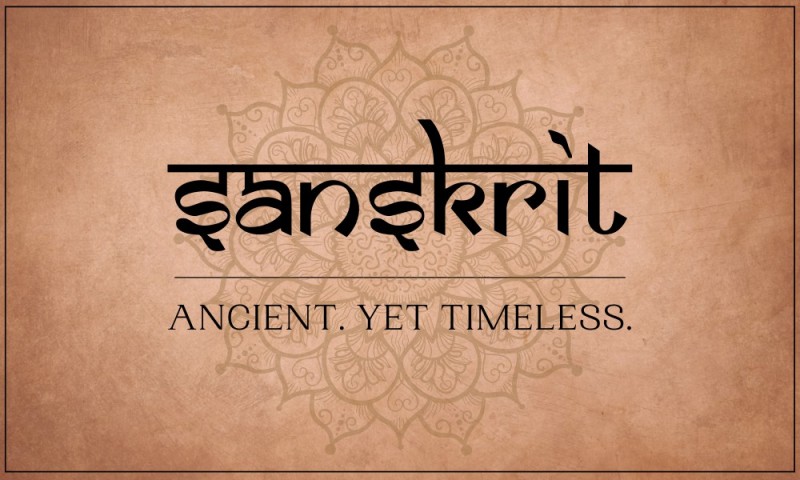“In the modern age of technology, progress and competition, why should a youngster spend time learning an ancient, out-dated language like Sanskrit?”
Valid question, right?
You’ve probably heard the following argument a lot of times before:
Sanskrit is the mother of all languages. It is the basis of India’s history and one must learn the language to stay connected to one’s roots.
You probably scoffed at this statement and went on with your life.
But what if we told you that Sanskrit is not only the key to the past, but also the foundation of our collective present and future?
You’d be thinking, “I don’t know... Seems kinda far-fetched.”
We all know that Sanskrit is the language of our land. It is the key to our vast unexplored past.
It is the language of the Vedas, up-Vedas, the six philosophical systems (Shatdarshana), the Puranas and the Itihaas. In fact, it is believed that more than 95% of works in Sanskrit pertain to law, philosophy, science, mathematics, medicine, linguistics, astronomy and most importantly, spirituality. The list of scholars, thinkers, philosophers and poets in Sanskrit is unending. And so is the list of their works!
Sanskrit is the key to the treasure trove of 30 million manuscripts. Surprised? You’d be more surprised to know that we have yet to explore more than 99% of this knowledge! Concepts such as decimals, zero, geometry, algebra, trigonometry and calculus, and practises such as Yoga and Ayurveda (the earliest school of medicine known to humankind), are ALL written in Sanskrit!
That makes Sanskrit the one and ONLY link to this colossal amount of knowledge and heritage, right? Why would we want to lose this ONE link to our civilisational past?
You’re probably wondering, “This sounds like paradise for a History buff. But the world is moving forward, why should I be looking back?”
Well, we all agree that Tech is the Future, right?
What if we told you that Sanskrit is integral to several technological developments awaiting our future? From Information Technology to Artificial Intelligence and Machine Learning, Sanskrit seems to be the root of many such advancements.
Did you know that computer languages like FORTRAN draw from Sanskrit? In fact, in a study by NASA scientist Rick Briggs1, it was found that Sanskrit is the most unambiguous language, meaning it is extremely suitable for AI. Other languages depend upon syntax, diction, tone, etc. which prove difficult to convert to artificial language, whereas Sanskrit has no such barriers! Words in Sanskrit sentences can be ordered in any way and they still convey the exact same meaning.
This makes Sanskrit one of the very few languages that can aid future technology greatly!
It is even believed that the USA is creating 6th and 7th generation SuperComputers based on Sanskrit2. In fact, Panini’s Ashtadhyayi (Grammar rules of Sanskrit) inspired the “Backus Naur form” which forms the basis of context-free and generative computer grammars of today. Even linguists such as Noam Chomsky and Paul Kiparsky have applied Panini’s notions in their research.
Not just that, at least 17 countries across the world, today, have schools and universities teaching Sanskrit - from Germany, Ireland and Australia to China, the US, the UK and many others, including India!
Doesn’t seem so outdated now, does it?
Now you’re probably thinking, “Fair enough. People in STEM fields seem to need Sanskrit, I guess. But I’m not from STEM, why should I learn Sanskrit anyway?”
“What if we can use 100% of our brain?” This question seems to be trending on Social Media lately. Even movies like ‘Lucy’ seemed to show us some weird ways of maximising the brain’s usage.
Jokes apart, what if we told you that using Sanskrit ACTUALLY helps enhance cognitive function? IRL!
Hear us out.
James Hartzell, a Postdoctoral Researcher at the Basque Center on Cognition, Brain and Language, in Spain, talks about the neurological effect of using Sanskrit in our daily lives in the Scientific American.3
The brains of Vedic Pandits were studied through structural MRI scanning. Hartzell writes, “What we discovered from the structural MRI scanning was remarkable. Numerous regions in the brains of the pandits were dramatically larger than those of controls, with over 10 percent more grey matter across both cerebral hemispheres, and substantial increases in cortical thickness.” An increase in these metrics consistently points towards enhanced cognitive function. This inevitably leads to increased memory, concentration and attention spans!
Looking at it from another perspective, the phonetics of Sanskrit is rooted in the systematic and technical arrangement of vowels, diphthongs and consonants which are spoken with acute attention to the point of location, degree of resonance and effort of breath. The nuanced structure and intricate pronunciation in Sanskrit helps in speech therapy as well! In fact, it is widely proven that the vibrations created by chanting Sanskrit mantras induces a positive effect on the individual and causes a calming effect. Don’t we all need that today to help cope with our stressful, fast-paced lives?
Moreover, we all realise the importance of Yoga and Ayurveda in our lives, especially since the Coronavirus Pandemic happened. The rich knowledge on these two is originally found in Sanskrit! So if we don’t delve into Sanskrit in the contemporary times, we will, undoubtedly, lose out on essential information for our future generations!
So in the end, we ask you, “WHY NOT study Sanskrit?”
Jayatu Sanskritam. Jayatu Bharatam.
Notes:
1 https://ojs.aaai.org//index.php/aimagazine/article/view/466
2 https://indianexpress.com/article/lifestyle/art-and-culture/world-sanskrit-day-facts-5324532/
3 https://blogs.scientificamerican.com/observations/a-neuroscientist-explores-the-sanskrit-effect/




1 Comment
I loved your question "Why NOT Learn Sanskrit" I wish to ask "WHERE to learn Sanskrit and How?"